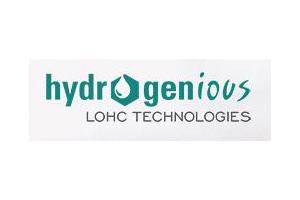Hydrogenious LOHC Technologies GmbH
-
0 comments

What is the innovation?
LOHC technology and logistics for hydrogen supply in Hydrogen Refuelling Stations (HRS)
What problem does the innovation solve?
To meet the EU’s targets to reduce greenhouse gas emissions by 80% until 2050, emissions have to be decreased drastically. However, decarbonisation of mobility and transport necessitates not only a substitution of fossil by renewable sources but also efficient ways to make volatile renewable energy available on mobile platforms. In this regard, hydrogen is a highly promising path. But how to decarbonize the mobility, if green hydrogen cannot be provided nationally or locally? The answer is simple: Just as fossil fuels are being imported and exported across borders today, sites with high renewable potential and low electricity costs must be used for hydrogen production in the long-term perspective. In doing so, storage and transportation of hydrogen at scale is the missing link on the targeted road to a green hydrogen economy. We develop and market an innovative solution for domesticating hydrogen by reversible chemical binding to an oil.
How does the innovation solve the problem?
The key component of our concept is an organic oil, the so-called Liquid Organic Hydrogen Carrier (LOHC). The principle is to chemically bind hydrogen to that LOHC via hydrogenation and to release it by dehydrogenation on demand. The benefits of this approach are striking: With no elemental hydrogen present during transport and by binding the hydrogen to a carrier oil, the existing fossil fuel infrastructure, including low costs and social acceptance, can become part of the renewable hydrogen supply chain. The targeted supply concept is similar to today’s supply of fossil refueling stations: Hydrogen is bound to the carrier at large central sources (e.g. wind parks) and then distributed to hydrogen refueling stations within the existing global fuel infrastructure, e.g. tankers, trains and trucks. At station, hydrogen is released from the carrier and provided for dispensing. The unloaded LOHC is transported back and reloaded with hydrogen – it can be reused for several hundred times.
Is there any other existing cutting edge solution? If so, how does yours differ?
The general principle of using LOHC for hydrogen storage and transport is utilized by other companies, albeit with different chemical systems and strategies. The toluene/methylcyclohexane system shows potential for very large single point to single point transport of hydrogen but is less efficient for hydrogen distribution to multiple consumers. Additionally, toluene is more difficult to handle due to toxicity. The same characteristics can be applied to methanol, which has long been announced as possible hydrogen carrier. Our LOHC approach combines the possibility to transport large amounts of hydrogen and thus renewable energy accross continents and borders via tank ships and a subsequent distribution of energy to multiple sites via railroad or truck transportation. These sites can be mid to large scale hydrogen refuelling stations, e.g. for bus depots, and the therefore needed storage infrastructure is already well-known and established.
Tell us about your team?
Hydrogenious as a company has grown intensively over the past few years to manage multiple projects in parallel for the installation of LOHC technology all over the world. We started our operations at our site in Erlangen end of 2014 with only a handful of people and ramped up our number of employees to approximately 90 persons by mid of 2020, while further recruitment is ongoing. Finance, Controllling & Procurement, Human Ressources and Business Development all have grown up their respective teams in the recent past and sum up to 20 people nowadays. The technical/technological department counts up to 70 people in 5 sections (engineering, project management, research & development, onboard technology, technology & product management). Our team is an inspiring mixture out of young and old, male and female, LOHC experienced guys and career changers, business specialists and technology geeks, which are all highly committed to install a fully sustainable, hydrogen-fueled society.
How big is the market for this innovation?
In 2017, thirteen leading energy and transport companies, including Shell and Toyota pledged to jointly invest $10.7 billion into fuel cell vehicles (FCEV) and infrastructure the coming five years. A recent study by Shell estimates that over 100 Mio. FCEV could be on the road by 2050 – up from only 6,500 by the end of 2017. To build the required HRS infrastructure, the Research Centre Jülich predicts a total needed investment of EUR 61 bn. and 10,000 HRS for Germany alone over the next 40 years. Assuming a 30% share of the CAPEX going into LOHC-based fueling stations, this would open EUR ~20 Bn. or over EUR 650 Mio per year for LOHC-fueling station technology in Germany alone. McKinsey&Co. in its 2017 report for the Hydrogen Council, even estimated a global investment need of USD 280 Bn. until 2030 to build the required infrastructure, showing the even larger global potential coming from this completely new market segment.
What EU-funded research project was this innovation developed in?
Project HySTOC.

